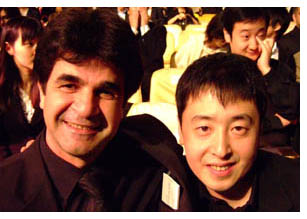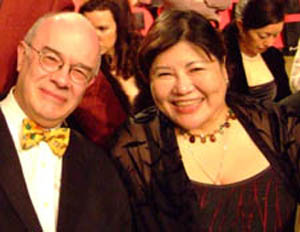Archive for the 'National cinemas: South Korea' Category
More light from the East
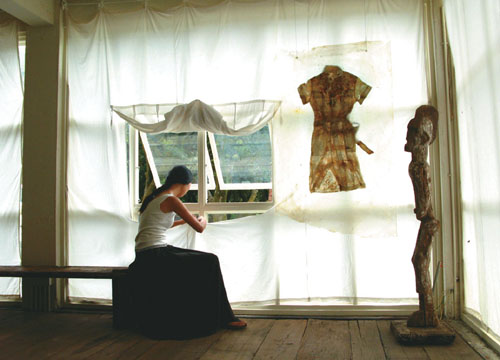
Useless (Jia Zhang-ke, China, 2007).
DB’s last communiqué from the 2007 Vancouver International Film Festival:
I’m so taken with José Luis Guerin’s En la ciudad de Sylvia (Spain/ France) that I’ll be devoting a separate blog entry to it soon. At Vancouver it was projected with his Unas fotos en la ciudad del Sylvia, a remarkable sketchpad for and rumination on the feature. Rubbed together, the two films throw off sparks. En la ciudad is in color and very tightly constructed, Unas fotos consists of hundreds of black-and-white stills linked by associations and intertitles, with no sound accompaniment. Guerin, an admirer of Murnau, says that as a young man he watched old films in “a sacred silence” and he wanted to try something similar.
Unas fotos may not be factual—call it a lyrical documentary—but it illuminates En la ciudad in striking ways and is intriguing in its own right. Structured as a quest for a woman the narrator met 22 years ago, the film moves across several cities and invokes as its patrons Dante and Petrarch, each of whom yearned for an unattainable woman. But this isn’t exactly a photo-film à la Marker’s La jetée; it uses dissolves, superimpositions, and staggered phases of action to suggest movement. The subjects? Dozens of women photographed in streets and trams. Some will find a creepy edge to the movie, but it didn’t strike me as the obsessions of a stalker. Guerin becomes sort of a paparazzo for non-celebs, capturing the many looks of ordinary women.
Watch this space for more on the many looks of Sylvia. For now, more Asian highlights from Vancouver.
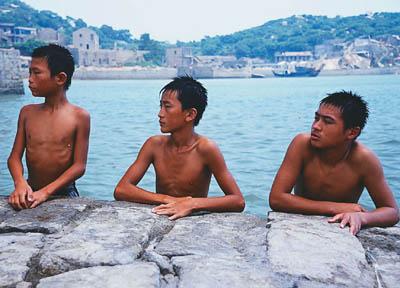
Fujian Blue.
Johnnie To and Wai Ka-fai have reunited for The Mad Detective (Hong Kong), which is as off-balance as you’d expect from its premise. Evidently spun off those TV series that feature telepathic profilers, the film stars Lau Ching-wan as a detective who solves cases by intuiting crooks’ “inner personalities.” We’re introduced to him crawling into a suitcase and asking his partner to throw it downstairs. After a few bumpy descents, he flops out and names the man who packed up a girl’s body the same way. Soon Lau is mentally reenacting a convenience-store robbery, and To/Wai cut together various versions of it as he plays with the possibilities.
Years after Lau leaves the force, his partner brings him back as a consultant to another case. By now, though, our mentalist has gone mental. The filmmakers get comic mileage, and some genuine poignancy, out of intercutting his hallucinations with what’s really happening. Lau envisions multiple personalities within the man they’re hunting, and as he traces out clues each personality flares up. To and Wai carry their dotty premise to a vigorous climax that multiplies the mirror confusions of both Lady from Shanghai and The Longest Nite. The brilliant sound designer Martin Chappell is back on the Milkyway team, making the effects and music magnify Lau’s heroic disintegration.
 Lee Chang-dong, of Peppermint Candy and Oasis, has won his widest acclaim yet with Secret Sunshine (Korea). As your basic domestic crime-thriller Born-Again-Christian female-trauma melodrama, it’s undeniably gripping.
Lee Chang-dong, of Peppermint Candy and Oasis, has won his widest acclaim yet with Secret Sunshine (Korea). As your basic domestic crime-thriller Born-Again-Christian female-trauma melodrama, it’s undeniably gripping.
Secret Sunshine earns its 130-minute length, because Lee needs time to do several things. He traces the assimilation of a widow and her little boy into a rural town. Then he must follow the remorseless playing out of a harrowing crime. He makes plausible her succumbing to fundamentalist Christianity and her growing conviction that she needs to forgive the criminal. And there are more changes to come.
For me the most unforgettable moment was the heroine’s appalled confrontation, in a prison visiting room, with the man who wronged her. His unexpected reaction dramatizes how religious faith can cultivate both emotional security and an almost invincible smugness. Jeon Do-yeon won the Best Actress award at Venice for her nuanced performance, and Song Kang-ho, best known for The Host and Memories of Murder, lightens the somber affair playing a man of indomitable cheerfulness and compassion.
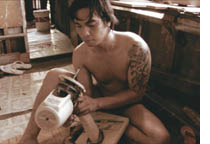 I found Brillante Mendoza’s Slingshot (Philippines) quite absorbing. Hopping among various lives lived in the Mandaluyong slums, it’s shot run-and-gun style, but here the loose look seems justified by both production circumstances and aesthetic impact. It was filmed on actual locations across only 11 days, and though it feels improvised, Mendoza claims that it was fully scripted and the actors were rehearsed and their movements blocked. Most of the actors were professionals, intermixed with non-actors—a strategy that has paid off for decades, in Soviet montage films and Italian Neorealism. Slingshot reminded me of Los Olvidados, both in its unsentimental treatment of the poor and its political critique, the latter here carried by the ever-present campaign posters and vans threading through the scenes. I suspect that the final shot, showing an anonymous petty crime accompanied by a crowd singing “How Great Is Our God,” would have had Buñuel smiling.
I found Brillante Mendoza’s Slingshot (Philippines) quite absorbing. Hopping among various lives lived in the Mandaluyong slums, it’s shot run-and-gun style, but here the loose look seems justified by both production circumstances and aesthetic impact. It was filmed on actual locations across only 11 days, and though it feels improvised, Mendoza claims that it was fully scripted and the actors were rehearsed and their movements blocked. Most of the actors were professionals, intermixed with non-actors—a strategy that has paid off for decades, in Soviet montage films and Italian Neorealism. Slingshot reminded me of Los Olvidados, both in its unsentimental treatment of the poor and its political critique, the latter here carried by the ever-present campaign posters and vans threading through the scenes. I suspect that the final shot, showing an anonymous petty crime accompanied by a crowd singing “How Great Is Our God,” would have had Buñuel smiling.
Off to China for Fujian Blue by Robin Weng (Weng Shouming). The setting is the southeastern coast, a jumping-off point for illegal immigration. The plotline has two lightly connected strands. In one, a boys’ gang tries to blackmail straying wives by photographing them with boyfriends, going so far as to sneak in homes and catch the couples sleeping together. The other plot strand presents Dragon, a boy who’s trying to sneak out of China and make money overseas. The whole affair is reminiscent of Hou Hsiao-hsien’s Boys from Fengkuei, and in Dragon’s story we can spot overtones of Hou’s distant, dedramatized imagery. Yet Weng adds original touches as well, including an almost subliminal ghost of London across the blue skies of the China straits.
 Fujian Blue shared the festival’s Dragons and Tigers Award with Mid-Afternoon Barks (China) by Zhang Yuedong. The two films are very different; if Weng echoes Hou, Zhang channels Tati and Iosseliani. (When I asked him if he knew the directors, he didn’t recognize the names.) Mid-Afternoon Barks is broken into three chapters. In the first, a shepherd abandons his flock and wanders into a village. An unknown man shoots pool. Dogs bark offscreen. The shepherd shares a room with another visitor, but midway through the night, the innkeeper orders them to put up a telegraph pole. When he awakes, the man is gone, and so is the pole. He wanders on.
Fujian Blue shared the festival’s Dragons and Tigers Award with Mid-Afternoon Barks (China) by Zhang Yuedong. The two films are very different; if Weng echoes Hou, Zhang channels Tati and Iosseliani. (When I asked him if he knew the directors, he didn’t recognize the names.) Mid-Afternoon Barks is broken into three chapters. In the first, a shepherd abandons his flock and wanders into a village. An unknown man shoots pool. Dogs bark offscreen. The shepherd shares a room with another visitor, but midway through the night, the innkeeper orders them to put up a telegraph pole. When he awakes, the man is gone, and so is the pole. He wanders on.
In the second episode . . . But why give away any more? In this relaxed, peculiar little film Beckett meets the Buñuel of The Milky Way and The Discreet Charm of the Bourgeoisie. As the enigmatic men without pasts or even psychologies wound their way through the long shots, Zheng’s quietly comic incongruities won me over long before the last dog had barked and the last ball had bounced.
Jia Zhang-ke is known principally for fiction films like Platform, The World, and Still Life, but from the start of his career he has shown himself a gifted documentarist as well. His In Public (2001) is a subtle experiment in social observation, and Dong (2006) made an enlightening companion piece to Still Life. Useless is more conceptual and loosely structured than Dong. Omitting voice-overs, Useless offers a free fantasia on the theme of China as apparel-house to the world.
The first section of the film presents images of workers in Guangdong factories as they cut, sew, and package garments. Jia’s camera refuses the bumpiness of handheld coverage; it opts for glissando tracking shots along and around endless rows of people bent over machines. (Now that fiction films try to look more like documentaries, one way to innovate in documentaries may involve making them look as polished as fiction films.) Jia also gives us glimpses of workers breaking for lunch and visiting the infirmary for treatment.
In a second section, Useless follows the success of a fashion house called Exception, run by Ma Ke. Her new clothing line Inutile (Useless) consist of handmade coats and pants that are stiff and heavy, almost armor-like, and that flaunt their ties to work and nature. (Some outfits are buried for a while to season.) Ending this part with Ma’s Paris show, in which the models’ faces are daubed with blackface, Jia moves back to China and the industrial wasteland of Fenyang Shaoxi. There he concentrates on home-based spinning and sewing. Neighborhood tailors patch up people’s garments while the locals descend into the coalmines. A former tailor tells us that he gave up his work because large-scale clothes production rendered him useless.
Jia’s juxtaposition of three layers of the Chinese clothes business evokes major aspects of the country’s industry: mass production, efforts toward upmarket branding, and more traditional artisanal work. Without being didactic, he uses associational form to suggest critical contrasts. The miners’ sooty faces recall the Parisian models’ makeup, and their stiff workclothes hanging on a washline evoke the artificially distressed Inutile look. What, the film asks, is useless? Jia shows industrial China’s effort to move ahead on many fronts, while also forcefully reminding us of what is left behind.
Thanks to Alan Franey, PoChu AuYeung, Mark Peranson, and all their colleagues for a wonderful festival. They’re so relaxed and amiable, they make it look easy to mount 16 days crammed with movies. Be sure to check on CinemaScope, the vigorous and unpredictable magazine that makes its home in Vancouver. It gives you many gems online, but it’s well worth subscribing to.
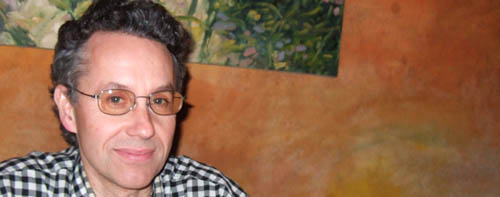

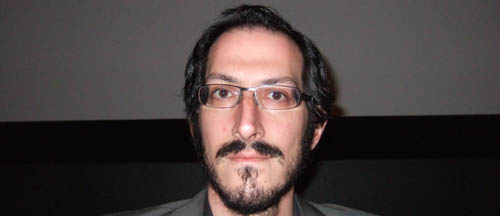
Alan Franey, Director of the Vancouver International Film Festival; PoChu AuYeung, Program Manager; and Mark Peranson, Program Associate and Editor of Cinema Scope.
A many-splendored thing 2: Awards aplenty
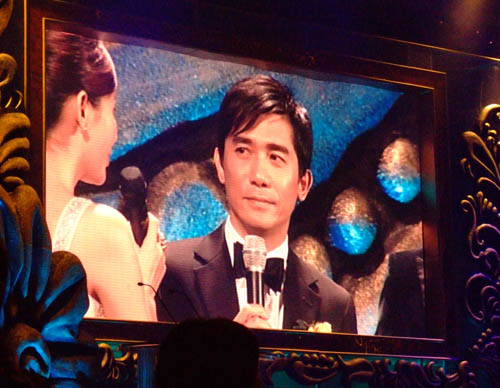
Short version:
This year the Hong Kong Entertainment Expo has launched the Asian Film Awards, a celebration of outstanding films and filmmakers created by the HK International Film Festival. Over 700 films were sifted by a jury and a handful of finalists were chosen in several categories. At the ceremony on Tuesday night, Bong Joon-ho’s The Host, which I wrote about at Vancouver’s film festival, won several: best film, best actor (Song Kang-ho, the put-upon father of the family), best cinematographer (Kim Hyung-goo), and best visual effects (The Orphanage). Best director honors went to Jia Zhang-ke for Still Life. Other winners:
Best actress: Miki Nakatani (Memories of Matsuko)
Best screenply: Mani Hagighi (Men at Work)
Best production design: Tim Yip (The Banquet)
Best musical score: Rahayu Supanggah (Opera Jawa)
Best editing: Lee Chatametikool (Syndromes and a Century)
A special award for Outstanding Contribution to Asian Cinema went to the great actress Josephine Siao Fong-Fong, presented by Luc Besson in an eloquent tribute.
I was fortunate enough to be given an award for Excellence in Asian Film Scholarship.
Long version follows.
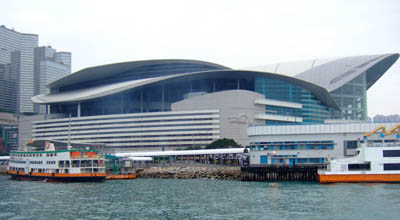
Tuesday morning-early afternoon: The film market, Filmart, is held in the overwhelming Convention Center on the harbor: at least seven floors of steel and glass, shaped like a wingspread gull and full of gigantic auditoria and meeting rooms. Sellers have set up booths to showcase films, TV shows, and the like. There’s also a film financing forum, where directors come to pitch projects to likely funders.
After getting my credentials, I shmoozed with old friend Shelley Kraicer, a Chinese film expert who’s a consultant for several festivals. I also spent time with Ho Yuhang, whose Rain Dogs I’d seen at Vancouver. Ho is a great fan of film noir, and I brought him some DVDs that seemed up his alley. He’s planning a psychological crime drama for his next project, and don’t be surprised if touches of David Goodis and Jim Thompson show up in it.
Late afternoon: After climbing into a suit, back to the Convention Center. At the preshow reception, met Fred Milstein, who works as a completion guarantor at Cine Finance; Fred went to film school, so we had several friends in common.
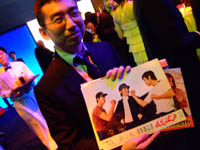
Also reunited with King Wei-chu, a programmer for Montreal’s wonderful Fantasia film fest, and Frédéric Amboisine, passionate adherent of Asian cinema and writer for the lush French magazine Kumite. (King and Frédéric awed me with the memorabilia they tote around, rare posters and books they’ll whip out to show you.)
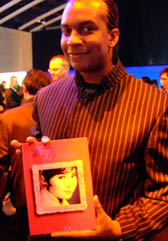
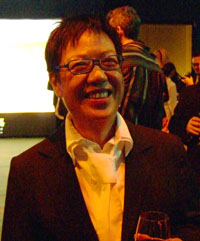
Also ran into director Ann Hui, looking happy and relaxed as usual. Ann, who’s one of Hong Kong’s best filmmakers, visited UW-Madison to show Summer Snow back in the 1990s.
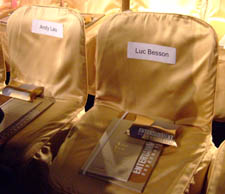
Evening: The ceremony approached. We spilled into the auditorium, with assigned seats. Mine was in the front row, and as I passed the center section I saw plenty of indications of star power.
I was lucky enough to be seated beside the remarkable Iranian director Jafar Panahi (The Circle, Offside) and next to him was Jia Zhang-ke, who remembered me from a panel we’d been on together in Shanghai. You can see that they were in good spirits. On my other side sat Vicki Zhou Wei and Song Kang-ho.
Before the curtain rose, I caught up with Tony Rayns, wearing an amazingly horticultural bow tie, and Peggy Chiao, the godmother of the New Taiwanese Cinema.
The big noise of the night was the presence of Korean pop star Rain, who brought shrieks from the crowd whenever he turned his head. Still, there was no shortage of fan response for Andy Lau and Tony Leung, the spokesman for Entertainment Expo.
The ceremony was principally in English, from a clever script written by the resourceful Grady Hendrix. Karen Mok started things off in her plummy English accent, but then David Wu showed up with his rapid-fire patter, eventually joined by Fiona Sit.
I missed some stretches because I had to go backstage before my award, but here are some pictures before and after. First, Mani Haghighi gets his screenplay award.
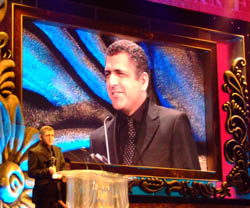
Here’s Siao Fong-Fong getting her special award:
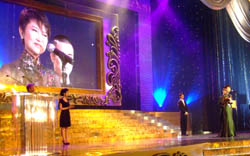
And here’s the Korean contingent as they realize they’re on a roll:
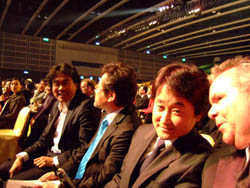
Late evening: At the afterparty, in a bar called JJ’s, I met with Grady, Stuart Levy of Tokyo Pop (who grasped the importance of Asian pop culture before nearly anybody else), his Japanese associate Matsuhashi Masashi, and several other folks—not least the indispensable Athena Tsui, who had worked very hard to make the Awards show a success. On the way out, got my picture taken with the charming Song Kang-ho.
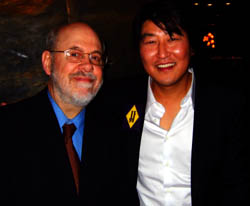
Later evening: Quiet dinner at a great fish restaurant with pals Yuhang and Michele, including Tony Rayns sans bowtie. We had some fine dishes, including pissing prawn (don’t ask).
Finally: Say hello to my lee’l fren’. The awards statuettes were designed by Wong Kar-wai art director William Chang.
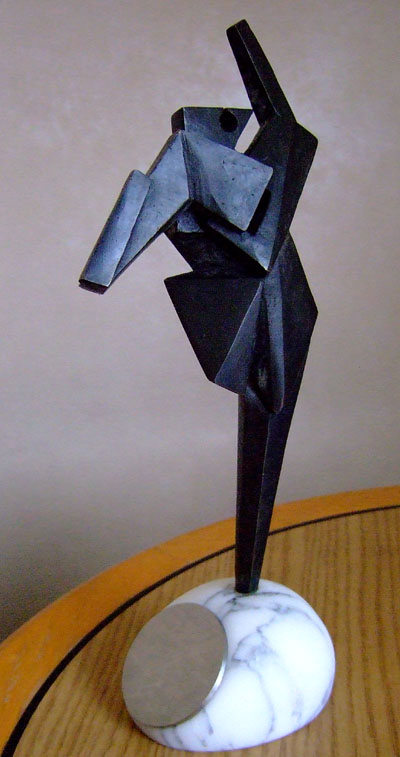
In the spirit of awards ceremonies: Thanks to everyone who’s helped me work on Asian film over the years, especially Tony Rayns, Donald Richie, Komatsu Hiroshi, Li Cheuk-to, Athena Tsui, Shu Kei, Sam Ho, Ding Yuin Shan, Stephen Teo, Doug Gomery, and Gabrielle Claes, along with several archives, festivals, and film distributors. Thanks also to Mr. Johnnie To, who kindly presented me with the award.
Updates and outtakes (in which we try, perhaps in vain, to catch up with ourselves)
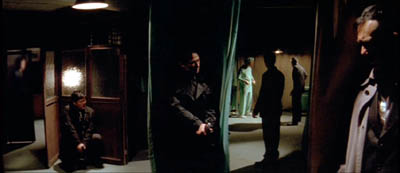
Exiled
Kristin writes:
“The Hobbit Film: New Developments” (January 13, 2007)
In this entry I discussed Bob Shaye’s recent claim that Peter Jackson would never get a chance to direct The Hobbit for New Line. I mentioned that one of the factors involved in the negotiations about who would direct is that the production rights will eventually revert to producer Saul Zaentz. I didn’t know the length of the option on those rights, which New Line currently holds. The January issue of the fantasy/sci fic magazine Locus says that the rights will revert to Zaentz in 2009.
Zaentz had owned the rights since the mid-1970s and sold them to Miramax in early 1997. Miramax had the two-film version of The Lord of the Rings in pre-production for about 18 months and then sold the rights to New Line in August of 1998. I don’t know what the source of Locus’ information is, but a twelve-month option would seem pretty plausible.
If that information is correct, New Line only has about two years to get the actual making of the film underway. It takes years for any big film to lumber into production in Hollywood these days, so the studio doesn’t have a lot of room to wiggle.
“By Annie Standards” (December 14, 2006)
Here I talked about methods for publicizing animated features. One way, I suggested, would be to foster audience interest in the various animation awards other than the Oscars. I remarked, “Under Academy rules, only three animated features can be nominated in any year unless sixteen or more such features are released that year. Then the number of nominations jumps to five, but so far that hasn’t happened. It may finally happen this year, if all sixteen features currently under consideration qualify under Academy rules.”
Close, but not close enough. On January 11, Variety announced that one film, Luc Besson’s Arthur and the Invisibles, had been disqualified as an animated feature. To qualify, a film must have at least 75% animated footage, and Arthur has too much live action.
With the number of qualifying features down to fifteen, only three can be nominated. Probably Cars will win, as I predicted in the original entry. It just won the Golden Globe in the newly established Animated Film category.
“Snakes, No, Borat, Yes: Not All Internet Publicity Is the Same” (January 7, 2007)
Here I suggested some reasons why Snakes on a Plane failed at the box office and Borat: Cultural Learnings of America for Make Benefit Glorious Nation of Kazakhstan succeeded, despite the fact that both garnered considerable fan-generated publicity on the internet. I mentioned that Sacha Baren Cohen had appeared on talk shows in character as Borat rather than in persona proper: “Each appearance by “Borat,” supposedly there to talk about the film, ended up being a hilarious performance by Cohen, ad-libbing on everything around him—the chairs, the coffee mugs, the cameras, the audience. Spectators ended up with one impression about the film: it was about this incredibly funny guy doing incredibly funny things.”
Trying to correct the widespread assumption that Borat was an improvised film, the January 8-14 issue of Variety ran a story about how Cohen worked with three scriptwriters, Peter Baynham, Dan Mazer, and Anthony “Ant” Hines: “The scribes even concoct Cohen’s dialogue for his promo appearances on ‘The Tonight Show’ and ‘Live With Regis and Kelly.’” Although Cohen presumably ad-libs to meet specific circumstances of each talk show, the publicity appearances are even more controlled by Cohen than I had assumed.
I also remarked that it is difficult to judge the degree to which the film manipulated the scenes of Borat’s encounters with real people. Especially in terms of editing and sound techniques, there was clearly much opportunity for this manipulation. The same Variety story goes on to say, “Much of the script had to be altered depending on how situations unravel. This means the writers ultimately end up producing the equivalent of multiple scripts, much of which ends up on the cutting room floor.” I’m not sure how chunks of scripts can end up on the cutting-room floor, but the point is that the filmmakers were carefully stitching the “documentary” scenes together on the script level and presumably would do so through stylistic means as well.
David writes:
Back to the Hotel
The Uchoten Hotel (aka Suite Dreams, blogged here) has acquired yet another English-language title: Hotel Avanti. It made it to #93 on Variety‘s list of the world’s 100 top-grossing films, with $51 million box office in Japan and none yet recorded overseas.
Speaking of Variety‘s list, the highest-grossing non-English language item turns out to be Bong Joon-ho’s Korean hit The Host (#59 at $84 million), due out in the US any month now. Only ten non-English-speaking films made the top 100, and of those, three were European (including Volver) but all the rest were Asian: Chinese (Fearless), Korean (The Host and King and Clown), and Japanese (Tales from Earthsea, Umizaru 2 Limit of Love, Hotel Avanti, and Japan Sinks–no rude remarks, please).
The entire list is in the 15-21 January hard copy of Variety, p. 15, but evidently it isn’t yet available on the paper’s site.
More on Johnnie To
In an earlier blog I praised Johnnie To as a director who shot and cut PTU smoothly and crisply. I waited through the fall, hoping somehow to see To’s latest, Exiled, on the big screen at one festival or another. No such luck. So last night I broke down and watched the DVD. Making full use of the widescreen format, To shows that classic technique can be at once rigorous and imaginative.
Exiled was more visually engaging than any US film I can recall last year, including Miami Vice. It immediately became my Best Film of 2006 That I Saw in 2007. (Runner-up: Children of Men.) I visited Milkyway while the film was being shot, and I hope to blog about the result in a future entry.
At Large on the Internets
On this very site, I’ve posted a new essay on action movies.
Annie Frisbie interviewed me for the Zoom-In podcast here. Annie is also blogging/reviewing Sundance films here.
Fox Independent visited Madison and posted videos on its site. The setup and the interview with filmmaker and teacher Erik Gunneson are here. An interview with me is here.
Speaking of Asian film….
Did you know that South Korea represents the fifth largest theatrical box office in the world? (More than Germany.) Or that Korean films and TV shows are sweeping Asia, with middle-aged ladies in Japan and the PRC swooning over SK pop stars? Or that Hong Kong star Andy Lau Tak-wah (Infernal Affairs, As Tears Go By, Running Out of Time) has been in 130-plus movies?
Variety for October 9-15 has a nice supplement pegged to the Puchan Film Festival detailing what’s on there. Kristin and I went once, and we had a great time (despite my coming down with pneumonia). It’s fall’s most important Asian film festival, with Hong Kong playing a parallel role in the spring. Online you can go to VARIETY or SCREEN INTERNATIONAL.
This year’s outing gives the award for Asian Filmmaker of the Year to Andy. He is of course a major pop idol–singer, TV star, film star, and model for fashion, shoes, watches, cameras, and God knows what else. After twenty-five years in the business, he still has charisma; I’ve seen a stadium full of teenage girls burst into a frenzy, screaming, “Tak-wah!”
Andy’s used his clout to benefit local and regional cinema. His production company Focus has supported a lot of recent work, notably Crazy Stone, and his First Cuts program underwrote such films as Patrick Tam’s After This Our Exile and Ou Yuhang’s Rain Dogs. (On the last, see my Vancouver blogs). And Andy is only 45 (though he looks about 30, dammit).
DB












